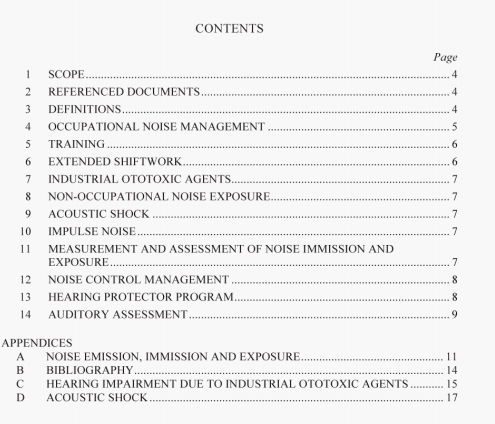AS/NZS 1269.0:2005 pdf – Occupational noise management Part 0: overview and general requirements.
The type of measuring instruments and procedures to be used for the measurement of noise levels will depend on such factors as the type of workplace, type of noise, work patterns and information required.
12 NOISI CONTROL MANAGEMENT
12.1 General
AS/NZS 1269.2 outlines noise control management strategies that should be implemented in both existing and proposed workplaces. ASINZS 1269.2 is applicable to all workplaces and all types of noise. including those produced by human aclivity.
12.2 Strategies for noise control management
Noise control management strategies should recognize that—
(a) noise control is the most effective method of preventing noise injury in the workplace:
(b) engineering noise controls are preferred over administrative controls:
(c) employees and supervisors should he fully informed about noise problems and involved in the development of solutions: and
(d) expert advice should be sought when dealing with technically complex situations.
12.3 Key elements of noise control management
Key elements of the strategies are as follows:
(a) Noise control planning for new workplaces, including clear consideration of noise
when specifying—
(i) building requirements:
(ii) work processes:
(iii) workplace layout: and
(iv) machinery noise emission limits.
(b) Management of noise in existing workplaces, including—
(i) defining responsibilities of managers. supervisors and other employees:
(ii) setting up a buy-quiet’ purchasing system for future plant and machinery purchases:
(iii) providing information and training:
(iv) identifying and ranking existing noise problems:
(v) investigating treatment options:
(vi) formulating and implementing a noise control plan: and
(vii) monitoring and evaluating implementation of the plan.
AS/NZS 1269.3 outlines the administrative responsibilities associated with a hearing protector program, discusses the selection, use and maintenance of various types of hearing protectors and gives iritbrmation on training and motivation in regard to hearing protector programs.
The attenuation of hearing protectors is measured by the procedure specified inAS/NZS 1270. The extent to which laboratory attenuation is approached in real-worldworkplace conditions depends on factors including the degree of diligence in theimplementation of a hearing protector program as described in AS/NZS 1269.3.
The enormous diversity of hearing protectors (both earplugs and earmuffs, their wide rangeof attenuation and variations in their correct fitting) necessitates close attention to one-on-one fitting instruction,supervision, motivation and evaluation under workplace conditions.In reality,one-on-one fitting instruction may not always be possible. In such cases,earmuffs are considered more likely to approach laboratory performance than earplugs.Where earplugs are the type of hearing protector supplied or desired, then frequent training,supervision and motivational one-to-one instruction appear to be required to increase real-world attenuation to values approaching laboratory results.
AS/NZS 1269.0:2005 pdf – Occupational noise management Part 0: overview and general requirements
